ADAPTABLE LIVING
Prepping for aging in place

The pitfalls of shared facilities, board accountability and tips for updating employment contracts



Prepping for aging in place

The pitfalls of shared facilities, board accountability and tips for updating employment contracts


Trusted for over 65 years, we are your proven performer within the Condominium Property Managers and Commercial Real Estate Market. We’re proud to be your premium choice, full-service exterior contractor for large municipal, industrial/commercial, and private projects.
EXPERIENCE. LOYALTY. QUALITY. DEPENDABILITY.
Pacific Paving Ltd. 5845 Luke Road, Unit 204 Mississauga, ON L4W 2K5 T (905) 670-7730 F (905) 670-7631 info@pacificpaving.ca pacificpaving.ca
ASPHALT PAVING | CONCRETE WORKS | WATERMAIN REPAIRS
CIVIL WORKS | BUILDING RESTORATION SERVICES | 24 HOUR EMERGENCY SERVICES









By 2035, Canada is projected to become a nation with one in four residents surpassing age 65. Since disability can naturally accompany the aging process, it is becoming more imperative to facilitate accessible and safe living environments in condominiums.
During a recent conversation with Brad McCannell, vice president of access and inclusion at the Rick Hansen Foundation (RHF), he shed light on why condo boards must view their maintenance and renovation projects through the lens of people with disabilities.
One feature for this month looks at how condo boards can help transform their communities into more adaptable living environments so more people can age in place—which the RHF defines as “the ability to live in one's own home and community safely, independently, and comfortably, regardless of age, income, or ability level.”
Also in this governance-focused issue is an article on the growing consensus in the industry regarding more robust oversight of condominium boards and a look at retaining cleaning and security staff using a multi-faceted approach.
Another feature deep dives into the contentious issues stemming from shared facilities agreements, which can become extremely complex. How can multiple parties that share a building develop a collaborative working relationship? What are some key areas of attention when reviewing such an agreement? There is so much to consider.
Plus, look for articles on employment contracts (updating them will help ensure compliance and limit liability), board elections, how to best inform owners about tricky news like capital repair projects, and some tips for eco-friendly living and small space design.
As the aging population grows across Canada, changing the way people live, the condo industry will play an important part in supporting the options people have when it comes to finding comfortable and safe dwellings.
Rebecca Melnyk Editor, CondoBusiness rebeccam@mediaedge.ca
Editor Rebecca Melnyk
Advertising Sales
Jake Blanchard, Sean Foley, Ron Guerra, Melissa Valentini
Art Director
Annette Carlucci
Graphic Designer
Roxy Huynh-Guinane
Production Coordinator Ines Louis
Contributing Writers
Jack Albert, Salim Dharssi, Earl Ducharme, Ryan Edmonds, Laura Gurr, Todd Hofley, Val Khomenko, Bri Macdonald, Wendy Macdonald, Lyndsey McNally, Alexis Radojcic, and Sally Thompson.
Subscription Rates
Canada: 1 year, $30*; 2 years, $55*
Single Copy Sales: Canada: $10*.
Elsewhere: $12 USA: $85
International: $110 *Plus applicable taxes
Reprints: Requests for permission to reprint any portion of this magazine should be sent to info@mediaedge.ca.
Circulation Department
Adrian Holland circulation@mediaedge.ca
CONDOBUSINESS is published four times a year by
President Kevin Brown
Director & Group Publisher
Sean Foley
Accounting Manager Michele Therien
2001 Sheppard Avenue East Suite 500 Toronto, Ontario M2J 4Z8 (416) 512-8186 Fax: (416) 512-8344 e-mail: info@mediaedge.ca
CONDOBUSINESS welcomes letters but accepts no responsibility for unsolicited manuscripts or photographs.
Canadian Publications Mail Product Sales Agreement No. 40063056 ISSN 0849-6714 All contents copyright MediaEdge Communications Inc. Printed in Canada on recycled paper.
/condomediaedge /condobusiness /condomediaedge





































As we look at elections in the political sphere on the news, the importance of governance, accountability, and community participation in condominiums moves sharply into focus. At the heart of condominium governance lies the board—a body elected by unit owners tasked with making key decisions that shape the future of the condominium.
BY LAURA GURR

Board elections are a vital aspect of governance, offering owners the opportunity to influence the direction of their community. Unfortunately, these elections are sometimes plagued by low turnout and limited engagement, with few candidates willing to stand for election in these volunteer positions.
This poses a significant challenge. Engaged and well-functioning communities are more likely to elect boards that will manage finances responsibly, address maintenance issues efficiently and foster a positive living environment. Boards that are disconnected from the community or dominated by a small group of individuals can lead to disengagement and governance issues.
Other communities have highly contested and fraught elections each and every year, posing a different challenge. High-conflict elections
can have devastating and long-term impacts, leading to costly and protracted litigation.
Ideally, communities want to be somewhere in the middle, with an election process that is engaged and competitive, but not high conflict. Given the authority vested in the board, it is essential for owners to take an active interest in the election process, ensuring that the most qualified and committed individuals are entrusted with these responsibilities.
neighbours is better positioned to foster a sense of unity and address potential conflicts before they escalate. Condo living is a shared experience, and board members who focus on inclusivity and mutual respect will help maintain harmony.
Running a successful board election starts with encouraging greater participation from unit owners. A lack of awareness or apathy can result in low turnout. To counteract this, boards should proactively communicate the significance of elections, provide clear information about candidates, and make the voting process as accessible as possible.
Board members require a variety of skills to navigate the complex responsibilities of governance. Legal and financial knowledge, project management skills, and a clear understanding of the condominium’s by-laws and rules are all important. However, the most critical quality is a commitment to putting the community’s best interests above personal interests.
Effective board members should prioritize transparency, communication, and fairness in decision-making. They should also be willing to work collaboratively, not just with their fellow board members, but with property managers, legal professionals, and unit owners.
Strong leadership also requires empathy and a sense of community responsibility. A board member who understands and values the experiences and concerns of their
Send timely reminders to all owners about the election date, the voting process, and the roles of board members. It is also helpful to provide candidate bios and information in advance, allowing owners to make informed decisions. Some communities find it useful to organize meet-and-greet events or virtual sessions where owners can interact with the can-
didates, ask questions, and learn more about their platforms. These sessions encourage transparency and allow candidates to outline their vision for the condominium.
The current board should consider succession planning and actively encourage a diverse range of candidates to fill vacancies and ensure turnover occurs. A board that reflects the demographic and cultural diversity of the condominium is more likely to be attuned to the needs of the entire community. Directors who serve their communities for multiple terms (or multiple decades) can be a significant benefit, allowing for board members to develop expertise and deepen their knowledge.
However, the introduction of fresh perspectives can be important for the transition of knowledge and to allow greater representation of the community’s evolving needs.
The mandatory proxy form, although not very new, can still be difficult for owners to complete. Recognize that some people may be unable to vote in person. Providing a clear process for proxy voting or electronic voting ensures that all voices are heard, even from those who cannot physically attend the election. The board should also take steps to ensure that the election process is conducted fairly and transparently. This may involve appointing an independent
chair, election monitor, or using an online voting platform to minimize the potential for disputes or irregularities in the counting of proxies and ballots.
While board elections are an essential aspect of governance, they also serve a broader pur-
pose—fostering a sense of community within the condominium. A strong and engaged board can help build connections among unit owners, promote collective responsibility and create a positive environment where everyone feels invested in the condo’s success.
To that end, it is important for board members to remember that they are not only managing a physical building; they are governing a community of people with shared interests and concerns. During election season, both candidates and owners should be mindful of the long-term impacts of their choices, not only about whom they vote for, but also about how the election is conducted. The election and the election process should focus not only on financial and operational matters but also on the health of the community itself. 1
Laura is a managing partner with Cohen Highley LLP and is part of the multi-residential housing group. Her practice focuses on condominium law, acting for condominium corporations, property managers, and developers in a broad range of litigation, operational and governance matters. Laura is actively involved in the condominium and multi-residential housing industry. She regularly writes and speaks about legal issues affecting the industry. Since 2014, Laura has been a board member of the Canadian Condominium Institute (London Chapter) and on the board of directors for Homes Unlimited (London) Inc.







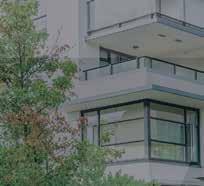



Looking for a reliable partner to help bring your building project to life?



Look no further than Egis, formerly known as McIntosh Perry. With a staff of over 600 professionals and technical experts, we offer a comprehensive range of consulting engineering and technical solutions that cover all stages of a building project. From concept to completion, we work with you every step of the way to turn your possibilities into reality.





Trust Egis to help you achieve your building g oals with our full range of services for the building industry.

















Communication tips for finding middle ground between boards and owners
An all-too-common occurrence at owners’ meetings is the surprise residents feel when financial shortfalls for major capital repair projects are up for discussion.
Some would argue that owners are apathetic and should pay closer attention to notices or participate in every owners’ meeting to stay up-to-date. Others might say condo corporations should focus more on when and how they are communicating so that owners have a better opportunity to understand what is happening in their community.

What is the best way to find middle ground so owners don’t feel ambushed when difficult news is delivered?
Back to basics
Communication is critical in a condo community. Notices and newsletters inform owners about disruption related to construction, unit
BY LYNDSEY MCNALLY
access, fire alarms, and more. But are boards effectively communicating all the planning work that goes on behind the scenes? The planning process can take years, particularly for major capital repair projects, but owners are often unaware of what is really going on. They may see in the reserve fund study what projects are expected and they receive notice when the

deliver the same message. Being considerate of how people consume information will offer maximum reach and minimize surprises.
Get the board talking
Being a board member involves long hours and difficult decisions—all while trying to be part of the community. As such, some boards rely on their managers to deliver every message,
but eventually, the elected leaders will need to speak directly to their neighbours.
This often happens at the annual general meeting where the president will deliver a report. While a good start, there may be owners who cannot attend or new community members moving in throughout the year. Think about adapting the president’s report into other forms of more regular communication.
work is scheduled, but what about all the stuff in between?
Engaging with owners regularly about what is being planned extends beyond the day-today operations. It’s also about proactive leadership, consistency, and providing opportunities to ask questions along the way.
Use multiple communication channels
Using digital communication channels is an essential practice for keeping owners up to date, but be aware that complete reliance on digital tools is a fools practice. Since many individuals shy away from technology, know your audience and connect in a way that works for everyone. In most communities that means using multiple communication channels to


Planning a capital repair project has many moving parts. Owners might strictly focus on how project execution will affect their lives, information which may not be known until the board has signed with a contractor. As well, the financial realities can change as planning progresses.
Many boards want to wait until they know everything before engaging with owners. If this is the case, construction will have already started and owners will know nothing. Communication must begin as early in the planning process as possible, which means being upfront about what is known and committing to keeping everyone informed throughout the process.
People do not like to be surprised. Not everyone pays as much attention as they should. But using reasonable efforts for transparency will minimize finger pointing when challenges arise.
After keeping people informed, if challenges arise, boards have an opportunity to engage ownership in the solutions. Don’t shy away

from owner information meetings, even if the subject matter is difficult or unpopular.
Delaying the conversation only provides an opportunity for people to get more worked up. Take a deep breath, face the conversation head on, and thoughtfully consider any feedback that is received, even if that feedback is negative.
This can present its own challenges as sometimes owners can be quite unreasonable; they may want the board to take no action at all, even if there is a statutory obligation that can’t be avoided. For this reason, when there are difficult discussions to be had, preparedness is key.
As a general rule, boards shouldn’t make blind decisions. They rely on their experts to guide them in the decision-making process. When complex resolutions need to be made, this usually involves written reporting to the board.
A common question at meetings is, “Can I get a copy of the engineer’s report?” This is often followed by the manager giving a complicated explanation of how records requests
work. These details are not secret, yet there are sometimes reasons to keep things confidential. Instead of waiting for someone to complain about needing more information, make it available from the beginning.
There is no sense guarding information that owners have the right to access anyway, and providing it helps ensure a productive owners’ meeting.
Ultimately, every decision the board makes will impact condo owners. Capital repair projects can be especially disruptive and have a major financial impact. Conversations about these issues can be tricky but are absolutely necessary. Timely, relevant, and transparent communication is key for success, and can help to reduce conflict when the unexpected happens. Don’t ambush owners with difficult news, and they will be less likely to ambush you in return. 1
Lyndsey McNally, OLCM, LCCI, CCI (Hon’s), is a Director at Condominium Lending Group and President of the Toronto & Area Chapter of the Canadian Condominium Institute.




Whiterose Janitorial Services Ltd. specializes in high-quality industrial, condominium and commercial cleaning and superintendent services. Founded as a small, family-run Canadian business in 1986, our professional cleaning services company has grown into a multi-faceted business providing a full range of quality cleaning services across Canada.

• Fully Customized Schedules
• Janitorial Services

• Floor Cleaning
• Window Cleaning Services
• Carpet Cleaning
• Garage Cleaning
• Pressure Washing
• Floor Polishing
• Construction Cleaning
• Stripping and Waxing
SUPERINTENDENT SERVICES
• Emergency Services/ On Call
• Live-in and Live-out Services
• Daily Readings
• Generator Tests
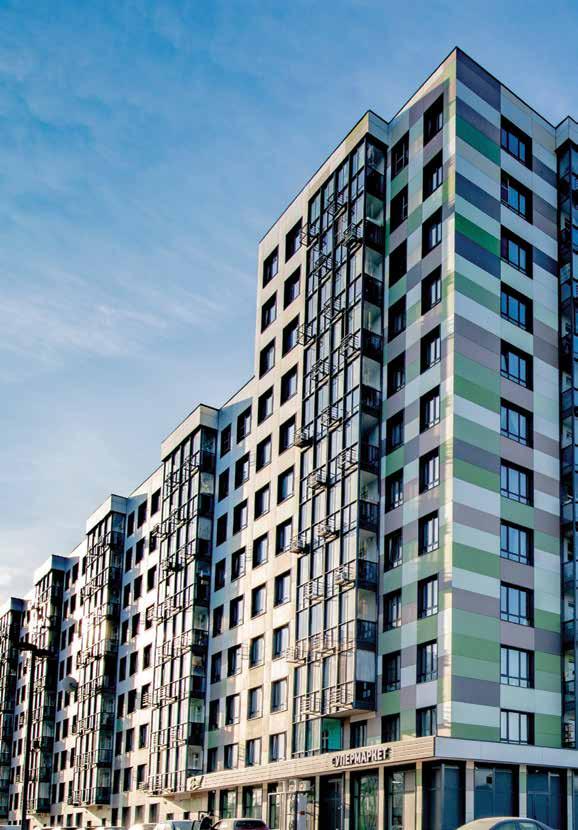
• Small Repairs
• Mechanical Systems
• Garbage Disposal Services
• Pool and Hot Tub Services

Drafting an employment agreement, and specifically a termination provision, is not a straight-forward task. It is common to see termination provisions like this:
“The Corporation may terminate your employm ent at any time without cause, upon providing you with notice or pay in lieu of notice as per the Ontario Employment Standards Act, 2000. If there is just cause for dismissal, the Corporation cy terminate your employment at any time for cause, without any obligation to you on account of notice or pay in lieu of notice or severance pay.”
Anyone thinking this condominium corporation is protected from wrongful dismissal claims would be wrong. Not only do courts in Ontario hold employers to strict standards when it comes to termination clauses in employment agreements, this standard can be akin to a moving target.
Since courts are always receptive to new and creative arguments that invalidate termination clauses, a provision that may have been sufficient years ago is now likely vulnerable to challenge.
The plain wording of a termination provision must accomplish two tasks: it must clearly and unambiguously state what a terminated employee will receive upon the termination of their employment, and it must not, in any way shape or form, provide less than what the employee is entitled to receive under employment standards legislation.
If a termination provision excludes any minimum statutory entitlement (inadvertently or otherwise), or doesn’t pass muster based on current case law, an employee becomes entitled to common law reasonable notice, which is
BY RYAN EDMONDS AND ALEXIS RADOJCIC
significantly more generous than the legislated minimums. Case in point, while statutory termination notice and pay in lieu is counted in weeks, common law notice is contemplated in months.
With that foundation, here are the top five reasons why a condominium corporation’s employment contracts need to be reviewed regularly:
Employment law is ever-changing. A termination clause deemed compliant by a judge five years ago may now be unenforceable due to new and prevailing precedents. With judges deciding cases regularly and the government periodically revising the legislation, drafting an enforceable termination provision can never be thought of as a one-and-done exercise. All too often we are forced to break the news to a

board and/or property manager that the termination clause drafted in 1999 for the superintendent they wish to terminate is invalid, and as a result, a dismissal that could have cost eight weeks of pay is now going to cost 18 months of pay or more.
When put in front of a judge, an employee’s entire contract comes under intense scrutiny. The employment contract may include termination-related clauses in other provisions, and if there is a deficiency in any provision that relates to termination, that single deficiency, regardless of its location, can bring all terminationrelated clauses crashing down. For example, an Ontario court recently invalidated an otherwise enforceable termination provision because part of the agreement dealing with confidential information purported to allow the employer to terminate in a manner offside with employment standards legislation.

“Excellence is not coincidental...
We don’t just smear paint unto a substrate, we go beyond that and even more. We apply invaluable decorating principles stemming from over 40 years of industry experience
• Exterior high-rise: painting, pressure washing, caulking, concrete repairs, waterproofing and stucco
• Interior and exterior painting including spray applications
• Parking garage painting and repairs
• Epoxy coatings
• Balcony slab waterproofing
• Concrete repairs
• Exterior stucco/EIFS applications
• Caulking
• Murals, faux finishes
• Wallpaper installation and repairs
• Corridor & lobby renovations including painting, tiling, carpeting, trim work, electrical, etc.
CLEAN CUT PAINTING & DECORATING CORPORATION t. 416.994.7383 f. 905.604.7383 e. peter@cleancutpainting.ca www.torontocommercialpainting.com

Garage & Balcony Assessment/Restoration
Building Cladding Design, Assessment & Remediation
Roofing System Design, Assessment & Remediation
Reserve Fund Studies
Performance Audits
Energy Audits and Modelling
Structural Engineering
Many employers mistakenly believe that their intention to comply with employment standards legislation is sufficient. Unfortunately, intention is not enough. A court will look exclusively at the contract’s wording. If the wording doesn’t comply with legislation, the termination provision is toast. Even an employer’s post-termination conduct (taking all the correct steps and providing all minimum entitlements) cannot rectify a deficient termination provision.
To top it all off, a court can also invalidate a termination provision simply because the language could be interpreted in more than one way. With the court’s inclination to side with non-unionized employees, a judge will interpret an ambiguous termination provision in the
employee’s favour, rendering it unenforceable and awarding a much more generous common law termination notice in its place.
Having an enforceable termination provision in an employee’s contract is the single most important thing a condominium corporation and/or property manager can do to limit liability for employee severance claims, otherwise known as “wrongful dismissal”.
Recently, a condo corporation was terminating a 64-year-old, part-time superintendent. The corporation employed the superintendent for approximately 30 years. If the corporation had used an employment agreement with a termination provision updated for today’s standards, the corporation’s liabilities would have been limited to eight weeks of pay
and benefits, plus payment of accrued vacation pay. However, because the termination clause was decades-old and thus completely unenforceable, it ultimately cost the corporation 21 months of pay, plus the cost of benefit continuation and bonuses over that period.
It is crucial to regularly review and update employment contracts.
Outdated employment contracts expose condo corporations to financial and legal risks they could otherwise avoid. By taking a proactive approach to regularly review and update employment agreements, ideally in conjunction with annual salary adjustments, boards and/or property managers can protect the corporation by ensuring compliance and limiting liability 1
Ryan Edmonds and Alexis Radojcic are condo lawyers at Lash Condo Law LLP.

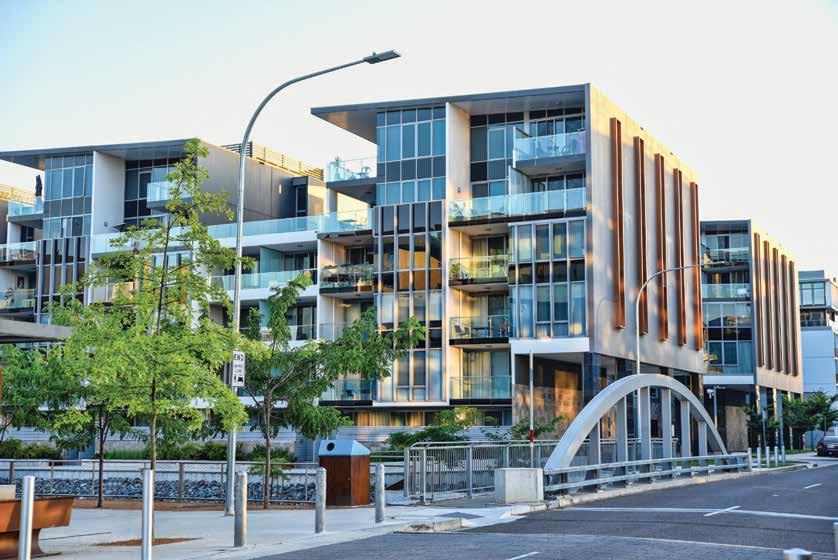










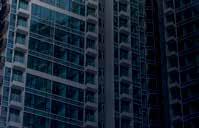















“Must Have” for Home Buyers
According to the Canadian Home Builders’ Association 2023 survey, overall energy-efficiency is number four on the list of “must haves” for Canadian Home Buyers.
Beyond the financial benefits, energy efficient homes and buildings contribute to a healthier living environment.
With this in mind, and as energy and utility costs continue to increase, condominiums are looking to energy audits for a clear roadmap towards optimizing building efficiency. An energy assessment is the first step to gaining control over resources, reducing operating expenses, understanding a building’s carbon footprint, and improving indoor environmental comfort. As the environmental impact of buildings throughout Ontario comes under increasing scrutiny, the importance of completing energy audits is quickly becoming apparent.
Ontario’s Energy and Water Reporting and Benchmarking (EWRB) now requires all multi-residential buildings of 50,000 square feet and over to annually report their building’s energy and water consumption. This means responsible condominium boards and building managers are carefully analyzing their building’s utility bills and paying greater attention to how much money they are spending on utilities alone. This often raises the question: How can we save? Ontario’s unique climate of extreme hot and cold draws on utilities according to the season and requires a whole building approach to reduce energy consumption, and consequently, carbon emissions.
One of the best ways for Ontario condominiums to define that approach is the American Society of Heating, Refrigerating and Air-Conditioning Engineers (ASHRAE) Level 2 Energy Audit. This is an in-depth study, analyzing two to three years of utility
usage to quantify base loads and identify seasonal variations. A level two study helps condominiums identify opportunities to improve energy performance through completion of a comprehensive visual review of all assets including HVAC, domestic hot water, plumbing, power distribution, and lighting—all of which impact a building’s energy consumption. This scope also includes the full building envelope: balconies, roof areas, windows, and cladding.
“Conducting a thorough assessment of the building to identify priority areas or systems with the highest energy consumption allows the condo board and owners to focus on upgrades that offer the greatest savings,” explains Sean Moore, Project Manager






of Energy & Carbon Reduction team with Pretium Engineering. “Our experience in existing building retrofits, combined with meeting directly with property managers and occupants, allows us to understand each building’s unique needs and identify key areas nearing the end of their service life, ensuring that we develop practical, tailored solutions.”
During an ASHRAE Level 2 Energy Audit, approximately 5-10% of all suites are inspected, including common areas to review the condition of energy consuming fixtures, equipment, envelope, balconies, doors, and windows. A complete exterior review of the site is also undertaken from grade, focusing on building cladding and energy consuming components such as exterior lighting.
Energy usage data is used to create a baseline to help measure energy savings for the proposed Energy Conservation Measures (ECMs). This baseline will measure the energy savings from proposed improvements and track future energy performance. It will also be used to calculate building energy efficiency using four (4) primary metrics:
• Building Energy Performance Index (BEPI): Total energy use divided by building size.
• Total Energy Use Intensity: Total energy use converted to a standard unit, equivalent kWh (ekWh), and divided by conditioned space within the building.
• Water Use Intensity (WUI): Total litres of water converted to a standard unit and divided by condition space within the building.
• Green House Gas Intensity (GHGI): Total energy use converted using local grid factors for gas and electricity divided by condition space within the building. GHGI is expressed as the amount of Carbon Dioxide (CO2)equivalent emissions per square metre of floor space per year.
“An ASHRAE Level Two energy audit helps the condominium board and property manager get an idea of how the building is performing. From there, we can explore the applicable retrofit/incentive programs to help further improve the return on investment,” explains Moore.
To support condominium corporations in their energy efficiency journey, a variety of incentive programs are available. Through programs like the IESO Ontario’s Save On Energy Rebates and Enbridge Commercial & Multi-Residential Air Tightness Testing Program, the available financial supports can offset the costs of implementing Energy-Conservation Measures (ECM) identified in audits. During the audit, Pretium will identify funding opportunities and provide high level estimates of their value. Once an audit is complete, Pretium can assist with fulfilling the requirements for the selected rebate application(s).
“An in-depth, full building energy audit has the potential to cut energy
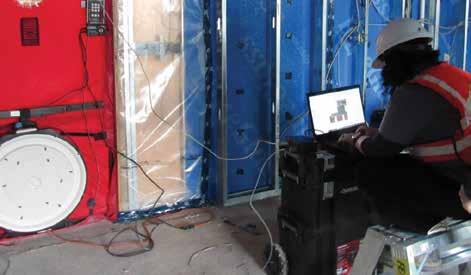
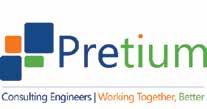
consumption and greenhouse gas emissions by 50-80%,” suggests Moore, who asserts that incentive programs are beginning to switch their focus: “Traditionally, incentive programs were primarily focused on reducing energy costs and usage, but we’re now seeing incentive programs focused on improving greenhouse gas emissions, accessibility and occupant comfort.”
As the incentive programs evolve, Pretium adapts their strategies to maximize the benefi ts of the latest financing and rebate opportunities available for their clients. Their skilled team of in-house envelope specialists, building performance modelers, engineers, and project managers, diligently seek out emerging incentive opportunities and the latest technologies to optimize project returns.
Upon audit completion, Pretium delivers a comprehensive report detailing estimated capital, utility savings, emissions reductions, operational cost reductions, payback periods, project timing, and available incentives for each Energy Conservation Measure (ECM). This report can be used as a road map for the condominium, allowing them to execute their chosen ECMs either as components near the end of their useful service life, or as funding allows.
By investing in a thorough energy audit and leveraging available incentives, Ontario condominiums can achieve a triple bottom line: reduced energy costs, improved resident satisfaction, and a smaller environmental footprint. This strategic approach positions these buildings as leaders in sustainable development.
To learn more, visit www.pretiumengineering.com

Common issues with accountability and the potential for future regulations
As more condominiums rise up across Ontario, boards play an increasingly vital role because they oversee the operation, both physical and financial, of these communities.
BY SALIM DHARSSI AND VAL KHOMENKO



1
One of the most common complaints from condo owners is the lack of transparency in decision-making. The Condominium Management Regulatory Authority of Ontario (CMRAO), which oversees condo managers, has said that board decisions are a top complaint it receives, despite having no jurisdiction over board directors. Some boards fail to provide clear communication about financial matters, renovation projects, or major repairs. Owners receive annual budgets and audited year-end financial statements, but these documents merely group revenue and expenses into high-level categories. Owners can be left in the dark about the specifics of how their fees are being spent, which can lead to mistrust and frustration. In extreme cases, boards have been accused of concealing important financial details or approving questionable expenditures without consulting owners.
2
While most condo boards refrain from abusing their power, some have been known to overstep their authority, imposing rules or penalties on owners without following the proper legal processes.
tor General in 2020. The report was presented by the standing committee on public accounts to the House in February 2023.
There were many recommendations, which the Condominium Authority of Ontario (CAO) and the CMRAO have since adopted. Currently, the scope of disputes and issues the CAO’s Condominium Authority Tribunal (CAT) can weigh in on is limited. The CAT cannot look into issues relating to board decision-making or governance, unless they relate to noise complaints, smoke migration, pets and records requests.
Aside from taking steps to call a special meeting of owners for the removal and disqualification of board directors, there is no other recourse available to owners to address board governance and decision-making problems, other than making an application to the Superior Court of Justice, which is a costly and time-consuming endeavor.
It is extremely difficult to remove or otherwise hold directors accountable, even if they have eroded the trust of the community. More interestingly, the standing committee recommended that the ministry of public and business service delivery should work with the CAO to include an array of key areas, such as board misconduct and fraudulent board elections.
has been scrutinized since the first condominium in the province went on sale in 1967. Some have argued that boards form a fourth level of government, with directors having almost absolute power over the affairs of their condominium corporations.
This level of authority eagerly invites the need for accountability, which is essential to ensure transparent governance, ethical decision-making, ongoing economic viability and for maintaining trust in the condominium model within the province. The vibrancy and viability of all condominium communities, including the broader housing market, depend on it.
Some boards may attempt to control every aspect of condo life, from withholding renovation requests or dictating renovation timelines, to inconsistently enforcing rules about pets, parking, or even how units are decorated, all based on their personal and subjective preferences. This type of behaviour often creates a hostile living and working environment, where owners, tenants and staff do not have certainty for how their actions will be treated; they can feel powerless and harassed.
3
Board members may also act in their own self-interest rather than for the good of the entire condominium. This manifests in various ways, such as favouring certain owners over others, hiring family members or friends to provide their condo with services without competitive bidding, or pursuing personal agendas that do not benefit the wider community.
These issues and the level of accountability and oversight were surely tested in the value-for-money audit, which was conducted by Ontario’s Audi-
Arguably, the writing is on the wall: the jurisdiction of the CAT will likely expand to include alleged board misconduct. Regulatory amendments and their proclamation into law can take time as they grind through political and administrative government processes.
In the meantime, condo boards should try to adopt and promote good governance practices by following these three simple steps:
1
Owners’ allegations about a director’s abuse of power and misconduct often stem from poor communication and asymmetric information. Board directors have all the information about their condominium’s operations, maintenance, repairs, capital projects, and spend. Owners receive practically none of this information, unless a board actively shares it.
Transparency requires more than just sharing board meeting minutes, which are brief and don’t capture details about discussions or the “why” behind the decisions being made. Transparency also requires more than sharing records because records don’t contain project plans, timelines, or
priorities of all the requests and maintenance work the board is tasked with.
In fairness to boards, fostering full transparency isn’t easy. Traditionally, boards don’t have a central place to keep all their records, project plans, and operational work. To improve transparency, get organized and locate all your condominium’s operational information in one place.
Good governance requires boards to engage with owners regularly and in a manner that allows owners to be heard. At a basic level, engagement requires boards to share information actively with owners. This includes maintenance records, spend, opinions and updates from vendors, reasons for decisions, and how they are prioritizing requests that owners and tenants are making.
At a more advanced level, engagement requires boards to have a communications strategy, which ensures owners appreciate the intent and nature of the message. Communications should not be a check-the-box type exercise. Finally, the best engagement comes when owners have the ability to ask questions and have a dialogue with the board or their property manager in a friendly and non-adversarial setting.
Condo boards are responsible for managing the affairs of their corporations, which includes making decisions and carrying out duties relating to financial, mechanical, structural, social and legal issues. To achieve good governance, board members must have a combined skill set that covers these areas. Otherwise, they are left with voids that may affect their decision-making and actions.
While it’s possible to fill gaps by hiring property managers and vendors (which is undoubtedly done and is the norm in the industry), a board with these skills across their members will have more success and encounter fewer issues because they won’t have as many blind spots.
Over the longer term, there is growing consensus in the industry about the benefits of furthering the oversight of condominium boards across Ontario. Some recommendations have included:
Bringing the condo governance disputes into the CAT’s jurisdiction as per the standing committee’s recommendations would be an alter-

HAVE QUESTIONS? CALL
Mississauga: (905) 206-0555
Toronto: (416) 260-0555

Solucore performs many types of Elevator solutions including:
• Maintenance inspections
• Technical audits and reviews
• Equipment condition surveys
• Accident investigations
• Due diligence inspections
Head
• Reserve fund studies
• Construction acceptance inspections
• Elevator Modernizations
• Evolve web based Portfolio Management tool
ing change of the Act’s self-governance model. The ministry of public and business service delivery should offer protection for condo owners and buyers by providing the CAO with inspection, investigation, and enforcement powers to ensure compliance with the Act.
Both organizations are already intertwined with information sharing, education, and registries. The value-for-money audit suggested that the CAO and CMRAO could be combined into one authority, with an estimated annual cost savings of up to $753,000. This move would establish a one-stop shop for all things related to condominium governance and management.
With the seven-year anniversary of the first wave of directors’ training expiring, education should be strengthened to focus further on governance and interpersonal relations. During the time of the audit, more than 6,000 directors (over 13 per cent) had not completed their training within the prescribed period of time.
Accountability in condo board governance is crucial for the well-being of any community and for stability of the housing market in Ontario, more generally. By fostering transparency, setting clear policies, encouraging resident involvement and ensuring that board members are trained and equipped to handle their responsibilities, the board can build a community based on trust, fairness and mutual respect. The government has an opportunity to act by adopting the recommendation from the value-for-money audit. Implementing these suggestions can help prevent conflicts, protect a property’s financial and physical health, and maintain a high quality of life for all residents of condominiums in Ontario. 1
Val Khomenko, RCM, OLCM is a Regional Condominium Manager with TSE Management Services Inc.,s providing full-service property management and consulting services in the Greater Toronto Area.
Salim Dharssi, BASc, JD is a two-term condominium board director and Founder and CEO of Managemate, a SaaS solution used by condominium boards and managers to reduce costs by centralizing their maintenance, capital project and record keeping processes.



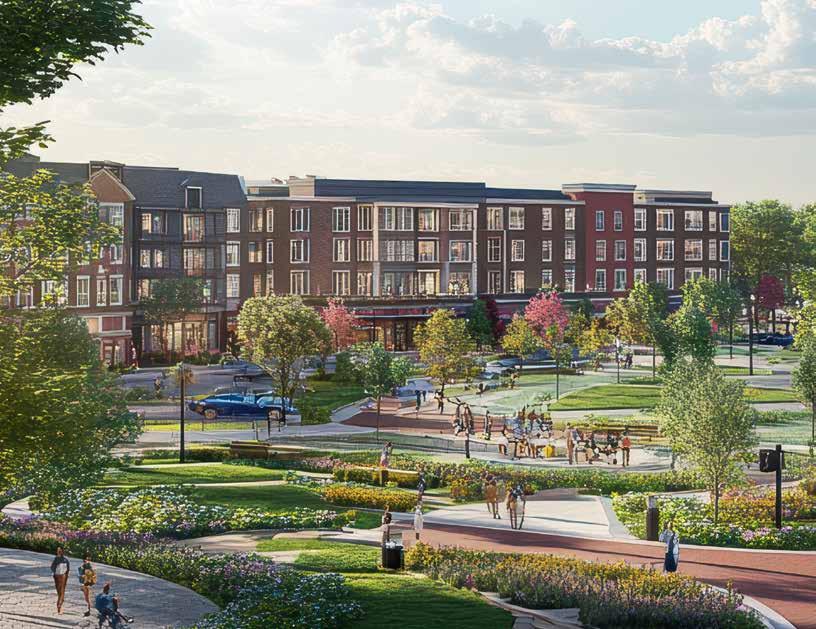
The common pitfalls of shared facility agreements and practical advice for navigating these challenges effectively.
Shared facilities exist at many condominiums and are the bane of the existence of managers and directors alike. During development, many stakeholders, from city planners to developers, each with their own agendas, converge to shape these spaces.
BY SALLY THOMPSON

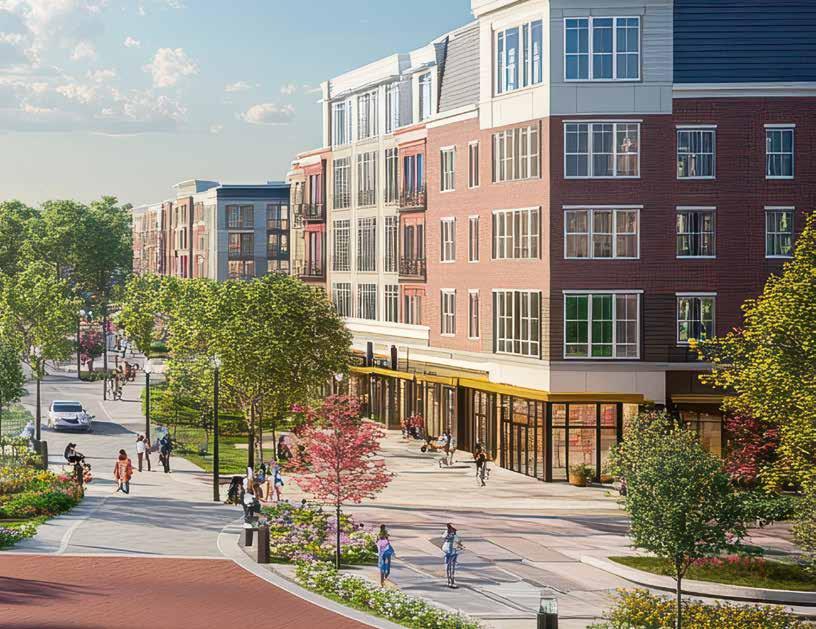
However, amidst this complex negotiation, the voices of future condominium corporations—the very entities that will bear the brunt of managing and maintaining these shared facilities—are conspicuously absent.
This oversight frequently results in convoluted agreements that are difficult to interpret and implement, leaving volunteer condominium boards grappling with unforeseen responsibilities and costs.
When a developer sets out to develop a condominium, there are many players at the table, all pushing for their own interests. The city wants a lively streetscape, with retail spaces at the base of the building. The developer wants to maximize the sellable gross floor area and profit. Another division of the city wants a new park or daycare. The province wants affordable
housing interspersed throughout the condominium units. The construction lender may not be willing to lend enough money to build all 70 floors of the building into a single condominium, which may result in the developer planning to register two condominiums in the same tower.
The result is a highly complex development with multiple parties occupying the final building or complex. The relationship among the various parties and how they will share in costs is set out in a site reciprocal or sharing agreement.
The one party who is not at the table during this negotiation is a representative of the condominium corporations who will end up responsible for the lion’s share of the costs and related efforts. And everyone at the table seems to forget that the volunteer condominium boards are lay people, with no formal training or special skills in operating a complex multi-component facility.
The outcome is often a shared facility agreement that is a quagmire of legal mumbo jumbo that is next to impossible to interpret and, even when interpreted, doesn’t always align with the as-built construction or worse, cannot be implemented as written. Many agreements completely omit significant and obvious shared components. For example, including a line item related to snow removal from a shared laneway, but not speaking to a $500,000 electrical switchgear or a $1-million roof that serves both parties. Many agreements set out the requirement for shared facility committees, but then structure in annoying voting requirements. A party who is only responsible for 1 per cent of a cost may hold the deciding vote in a setting where unanimous consent of a shared facility committee is needed.
If your condominium has shared facilities, you need to consider the agreement provisions from two perspectives: how are operating costs shared and how are capital costs shared.
Early in the life of a condominium, everything may seem to be going swimmingly. There are some costs, like cleaning a shared garage or changing some light bulbs, that are minor in nature. Utilities are hopefully well sub-metered and appropriately shared. The parties reach some harmony with respect to sharing the costs. They may even reimagine the agreement in a way that feels more logical to all involved. For example, you clean beyond this arbitrary line, and we’ll clean the rest. That can work reasonably well for several years, but often causes serious problems when major capital work becomes necessary. When hundreds of thousands or even millions of dollars are involved, suddenly everyone takes a more serious look at the legal wording of the agreement and runs for cover. This can result in a condominium corporation being on the hook for significant costs that they have not reserved for.
All condominiums with shared facility obliga
early on by their legal counsel and an engineer familiar with interpreting shared facility agreements. This should start with a summary of what is shared, ideally resulting in a list of shared equipment, components and spaces that all parties can agree to. Shared equipment might even be labelled as such on site. It should also include a review of the site to identify components, which are shared in practice, but have been omitted from the agreement.
Renegotiating the terms or amending the agreement twenty years before any significant capital work arises will be much easier than attempting to do it when a major capital project is imminent.
Some areas that deserve particular attention in this review:
• Incoming water services and outgoing sewers, cisterns and related sumps: these may be covered by some general wording, but it is better if they are clearly identified.
• Main electrical switchgear and transformers: not just the power consumed, the equipment itself.
Horizontal boundaries: for example, the
commercial/residential parking garage. Or the residential amenity terrace sits on top of the roof of the office component. Delineating who pays for repair and replacement in these cases is very difficult, but important.
• Roofs: does the roof on the 20th floor of the residential tower also serve the office component located on floors 2 to 6?
• Suspended access equipment: if there is a multi-floor office or retail entity at the base of a residential high-rise, they will need to use the suspended access equipment to repair their walls.
• If garage drive aisles and ramps are shared how will the ventilation, lighting, sprinkler systems and drains be handled, considering that these systems span both the shared drive aisles and non-shared areas?
• If certain service rooms are shared, is all the equipment located in the service room shared? If not, does the sharing of the room include air conditioning and ventilation equipment serving that room? Is the floor waterproofing shared?
• If site landscaping is shared, but it is located above one or more parking garages, who pays for what when the garage roof decks are excavated and re-waterproofed?

Have shared facilities been properly separated and sub-metered so the parties are paying their appropriate share of utilities?
At townhouse sites with significant roadways, which water mains and sewers located under the roadways are shared? If the phase two townhouse condominium corporation’s mains and sewers run under the phase one roadways, who is responsible for paving when the roads get dug up to replace the pipes?
“Shared with shared” components, for example, central plant equipment, like boilers or chillers, which serve shared amenities as well as serving one entity. Will a share of the cost of those components be considered shared?
Another thing that needs to be understood early on is how the reserve fund for the shared facilities is to operate. Many shared facility agreements set out the need for a shared facility committee. This committee may be required to develop an annual budget for operating costs. Some agreements require a separate reserve fund study and reserve fund account for the shared facilities. But many do not, particularly if one or more of the sharing entities is not a condominium.
If no shared facility reserve fund is required, then condominiums who are party to the agreement will still need to reserve to cover their shared obligations. This can be handled by including the corpo -

Having the technical expertise and insight to conduct retrofit projects in established buildings without affecting the day-to-day business of occupants is our specialty. It’s what sets us apart.
The truth is, existing buildings are far more complex and challenging than new construction, and require a unique game plan every time. It’s why the process for delivering mechanical and electrical engineering solutions requires more than a cookie cutter approach – it demands that you have a deep insight into the building and how new systems can be integrated into existing systems seamlessly. All of our projects are reviewed by senior engineers, each with over 30 years of experience in their respective fields, ensuring that our clients always receive engineering services of the highest quality.
T: 416-443-9499 | E: marketing@mcgregor-allsop.com mcgregor-allsop.com




















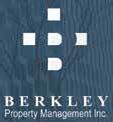





ration’s portion of shared costs in their main reserve fund study. This is often the simplest solution, so be glad if this is how your shared facilities are structured.
Some agreements call for a shared facility reserve fund, but don’t clarify the mechanics of the funding. This is a particular issue for agreements that include many different sharing ratios. For example, in a three-way shared agreement, the cost of the boilers may be shared on a 25/60/15 ratio, whereas the site may be shared on a 33/33/34 ratio. When different sharing ratios exist, I recommend against using a single reserve fund. Co-mingling money that is contributed according to different percentages often creates unnecessary confusion.
Let us say the three parties above set up a single account to accumulate money for both the boilers and the site. If the fund contained $110,000 of the 25/60/15 boiler dollars and $20,000 of the 33/33/34 site dollars, and then the entities wanted to spend $120,000 on the boilers, they would face a challenge. They cannot supplement the $110,000 contributed per the 25/60/15 boiler ratio with $10,000 of the 33/33/34 site dollars because then the parties would be contributing towards the boilers in the wrong share.
In these cases, I recommended either one reserve fund study and one reserve fund account per sharing type or separate reserve accounts for each entity. In the example, there could be two shared facility accounts—one where all parties contribute towards the boilers and a second where they contribute towards the site.
Alternately, a single study can cover both the boilers and the site, but in this case a separate reserve account would exist for each entity. The study would include two cash flow analyses, one for each entity, reflecting the aggregate of their shares of each category of sharing.
Some accounting software can track the contributions by each party and allocate each invoice per the appropriate sharing type, but we often find that managers using these systems struggle to reconcile the costs, making it difficult to know how much of the balance in the account is attributed to each entity. This opening balance information is needed for each reserve fund study update.
If all the sharing ratios are the same, for example, if two towers share the lobby, amenities, site and garage all in a 48/52 ratio, then one shared facility reserve fund study can be completed and one reserve account can be used for both parties. In this case, all the dollars in the account are 48/52 dollars, so they can be used indiscriminately.
At some sites, there is a shared facility committee that acts very much like the condominium’s board, overseeing a manager and budget for the shared facilities. They take care of all repairs for the shared facilities.
At other sites, one party is assigned responsibility for arranging for repairs to certain shared facilities and then presents an invoice to the other sharing party after the fact. This responsibility can be set out in an
itemized list in the shared agreement or can sometimes flow with property boundaries. In this case, there is generally a lot of dispute because the party receiving the invoice may feel that the work was unnecessary or excessively expensive.
Another layer of complexity exists if the motivations of the parties represented on shared facility committees are not always aligned. One party wants to keep the shared amenities in tip-top shape and the other just wants to minimize fees.
Or a commercial sharing partner wants to significantly upgrade the streetscape outside their retail units and unceremoniously presents the residential condominium with a bill for their share of the cost. All parties involved in a successful sharing relationship need to work hard to accept that the world will not always be perfectly fair and that compromise is sometimes needed to keep the peace. As
with everything, open lines of communication and transparency are key.
So, my warning to those with shared facilities is to proceed with caution. Understand what your agreement covers and what it misses. Create clarity early. Don’t just focus on utility costs; think about capital costs, too. Work hard to develop a strong working relationship with your sharing partners. Set out a vision statement for the shared facilities that attempts to align expectations. And keep the lines of communication open. If something feels unfair, it is very likely your sharing partner has something else they think is unfair. If you work closely and respectfully together, hopefully you can have a successful, war-free shared facility experience. 1
Sally Thompson, MSc P.Eng. LCCI, is a managing principal at Synergy Partners and president of CAI Canada.
Readers can find more insight into the complexity of shared facilities in Sally Thompson’s new book, Condo Questions and Answers, Ontario Edition, published this year by James Lorimer & Company. Her four-part book, which was written for condominium owners and directors, addresses the most common and unexpected problems facing condominium owners.
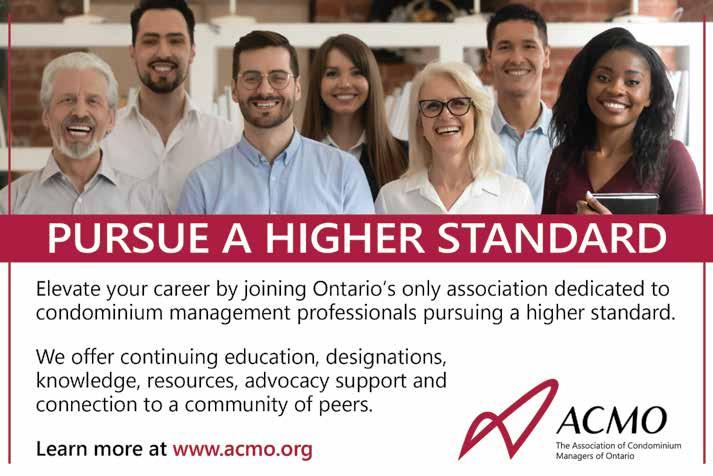
Contending with property damage is an undesirable, yet unavoidable, reality of condominium management. For this reason, having the right property insurance goes a long way toward protecting your financials and giving all stakeholders greater peace of mind.
That being said, is your property insurance the proper fit for your building? It’s a question that demands consideration, especially as property insurance is mandatory for all condominiums. For review, Ontario’s Condominium Act requires all standard registration condominium corporations to carry property insurance covering the common elements and the units, but not any betterments done to the units. Importantly, it clarifies the types of loss that a property needs to be insured against (aka “major perils”) and makes it clear that the insurable value must be the full replacement cost of the property. Additionally, the Act specifies that the insurance policy must be set up to protect three key parties, including the condominium corporation, each unit owner, and each unit’s mortgagee.
The mandatory requirement for property insurance for condos makes complete sense. Since unit owners collectively own the condominium, they want to protect their investment but do not want to bear any personal risk from an inadequate insurance limit or insurance companies that are not financially able to pay their claims during a catastrophic event.
Meanwhile, mortgage providers and lenders want assurances that a condo corporation’s insurance coverage will restore the livability and sellability of the unit by repairing damage to both common elements and the basic unit. Similarly, financial institutions that provide mortgages on condo units will often be concerned that the policy is insured to full replacement cost value at all times and insured with financially stable, A-rated insurance companies. Savvy owners will want to

















ensure this as well, as the intent of the insurance is to transfer risk to an insurance company.
So, what should a condo board look for to know if their property insurance is adequate? From a high level, you want to ensure your coverage program is:
• entrusted with stable and financially sound insurers;
• has a proper replacement cost limit of insurance;
• carries reasonable deductibles (as required by the Condo Act), and
• does not contain any co-insurance penalties.
There are additional points and tips to consider when assessing if your property insurance is the right fit. They include:
• THE AM BEST GUIDE: When brokerages evaluate the fi nancial stability of potential insurers, they will commonly consult the AM Best Guide. This is a reputable and independent rating agency that assesses the financial strength and stability of insurance companies.
An “A” rating indicates that the company has a strong ability to meet its financial obligations, including paying out claims. This verifies that the insurer has sufficient funds to cover potential losses and provides peace of mind to policyholders. Many large corporations and financial institutions require a minimum “A” rating for their insurers.
• REPLACEMENT COST APPRAISALS: To ensure your corporation carries an appropriate limit of property insurance, you should secure a replacement cost appraisal regularly. This report should be completed by an accredited independent third-party appraiser that carries an ASA or AACI designation. This will provide your board with assurances that your corporation is insuring its full replacement cost value and is in compliance with the Condo Act. Your declaration may specify how often to secure an accredited appraisal; but when in doubt, most condos observe the rule of thumb of every three to five years.
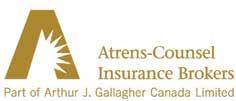
• REASONABLE DEDUCTIBLES: The Condominium Act specifies that a condo corporation’s property insurance may carry a deductible but that the deductible must be reasonable. The term “reasonable” is used often in the Act, and it essentially means that the deductible is appropriate (and not in excess) based on the details of your particular condominium.
In our experience, many condos carry a water damage deductible of $25,000 or $50,000 as they feel that it is a good “managing deductible” for the corporation. In essence, it allows the condo to charge back up to that amount to the responsible unit for the nuisance unit-to-unit losses but still allows the corporation to access its insurance coverage at a reasonable deductible level.
Coinsurance is a penalty designed by insurers to penalize an insured (and make them a co-insurer on the loss) when an insured’s property insurance limit is below the full replacement cost. As a basic example, if you have a coinsurance clause in your policy, and only insure to a limit that is 50% of the replacement cost value of your property, the insurer will only pay roughly 50% of any loss your corporation incurs. This makes the condominium, and ultimately the unit owner, a co-insurer in the loss.
Be cautious of workarounds that require a board member or property manager to sign-off on the insurable property value. These forms create significant exposure to boards and property managers and, if requested, should only ever be signed by an accredited independent appraiser. The most optimal option is to have your insurer remove any coinsurance penalties and provide a true no-coinsurance policy which offers maximum protection.
Between floods, fires, windstorms, and owner accidents, property damage is a near inevitability in a condominium. But when repairs or restorations are needed, there is value in being equipped with a properly-tailored property insurance policy that will insulate the condominium corporation from financial burdens and let everyone rest easier.
Tom Gallinger is Senior Vice President of Atrens-Counsel Insurance Brokers (www.atrens-counsel.com).
Anticipating the future needs of aging condo communities and viewing renovations through the lens of accessibility.
By Rebecca Melnyk


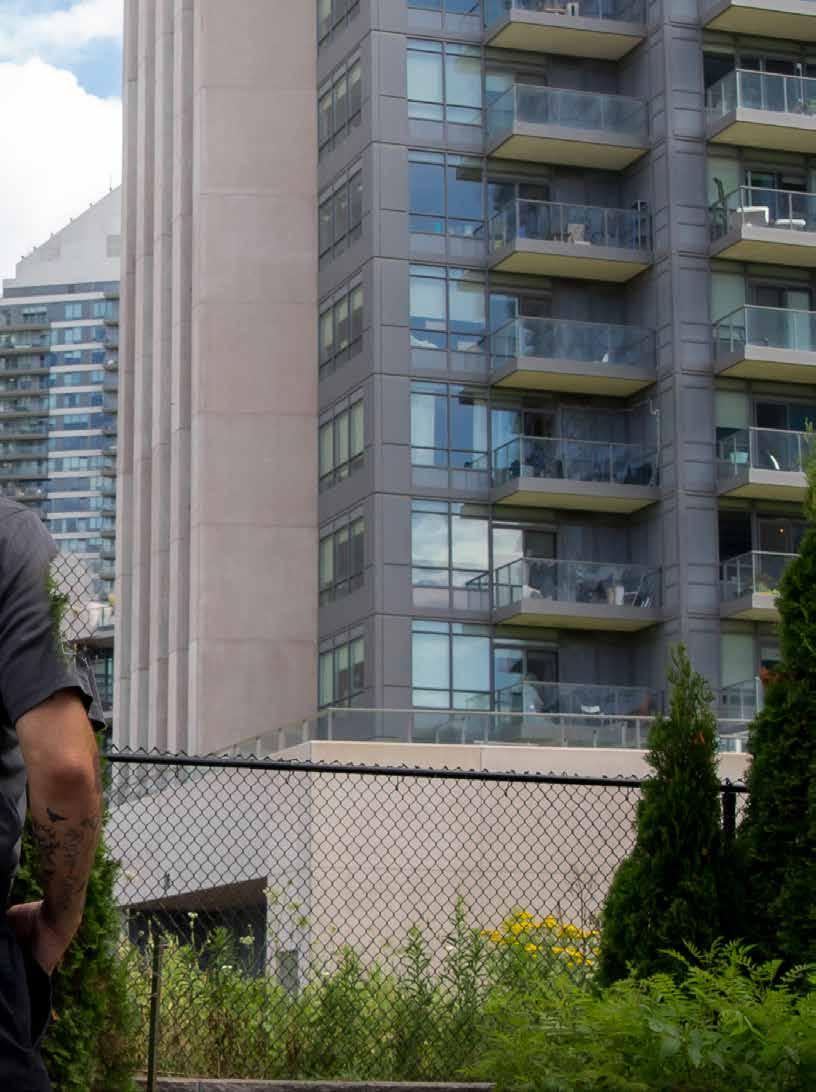

Closeto 87 per cent of Canadians believe there should be accessible housing for everyone, according to a newly released national accessibility study by the Rick Hansen Foundation (RHF). Yet most multi-residential buildings don’t anticipate the needs of an aging population, which comes with more disabilities.
Nearly two-thirds of Canadians have a disability or live with or take care of a family member with a disability. A report from Statistics Canada, released last year, found that between 2017 and 2022 the disability rate among seniors increased to 40 per cent.
“You’re only temporarily able-bodied,” says Brad McCannell, vice president of access and inclusion at RHF and a wheelchair user for 40-plus years. “Everyone will join our community sooner or later, so how do we accommodate that as condo boards and owners?”
McCannell, who is also a member of the Accessibility Standards Canada Board, urges condos to make a concerted effort to get both seniors and people with disabilities on their boards. “There is nothing like the lived experience,” he says. “Get that direct input and it will allow you to anticipate the needs going forward.”
Older condos often face greater challenges when it comes to adapting their property for long-term use, says Kirsten Dale, property manager with MCRS Property Management. She finds the needs associated with aging in place can be complex, but if well supported, residents can comfortably remain in their homes for as long as possible.
“When my firm begins working with a new community, we encourage residents to speak up often and early to express their wants and needs as this feedback helps us to plan for their long-term enjoyment of their invest-
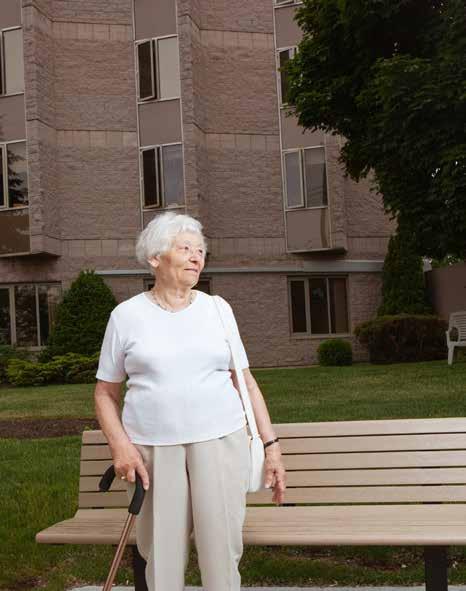
ment,” she says. “Our residents learn quickly that as they age and their needs change, their homes can evolve right along with them.”
Solutions can partly come from disability awareness training, which may include hiring knowledgeable consultants, as well as groupbased simulation activities that support teambuilding among boards. “Borrow a walker or wheelchair and try to navigate the common areas of your community,” suggests Dale. “Or put on a blindfold and try to find your way down to the refuse chute room in your hallway from your unit entrance. The ways you could help those with accessibility challenges will become clear very quickly.”
Condo lawyer Sonja Hodis, of Hodis Law, suggests that corporations think proactively and address accessibility issues during renovations and when reviews of the common elements are undertaken. “Just as they look at their common elements from a reserve fund study perspective, they need to look at them periodically from the perspective of accessibility,” she says. “Disability-related needs and accessibility are not just an age-related issue. Anyone could require accommodations to be able to equally access common elements. Condos need to ask themselves if their premises are accessible and, if not, what can be done to make them so.”
Sometimes government funding becomes available for accessibility projects. Dale says this funding can greatly assist in offsetting the cost of what would otherwise be an added expense to the community.
While planning, McCannell says a first step is understanding how every site is different. “If you are reactive to aging-in-place solutions, you’ll always be behind,” he adds. “The important thing is to get ahead of the needs of the community and understand there's no onesize-fits-all solution. Every single building will have unique tenants, owners and features.”
Such an approach will give residents greater control over their future independence; yet sometimes there are situations where owners or residents, despite their age, can no longer live on their own for their own safety or the safety of others. Hodis says it is important that property managers have current and up-todate emergency contact lists, including names of powers of attorney and estate trustees. “A lot of condos don’t know who to contact if something happened to a resident or if there are issues with the unit and the resident is incapable of dealing with them,” she says.
From a legal perspective, she also cautions that condos are not long-term care facilities. She has seen people move elderly family members into a condo and then rely on condo staff, management and board members to take care of the individuals who cannot live independently. “This is outside the scope of what the role of the condo corporation is,” she says. Condos have to be careful that they don’t overstep that boundary and take on responsibilities and liabilities that they shouldn’t.”
While many seniors are generally quite capable as far as accessibility is concerned, Dale adds that sharing information with a community about the range of non-medical assisted living services can help them plan and prepare.
Before undertaking accessibility projects, Dale points out four categories to consider: physical, cognitive, auditory and visual. For instance, when replacing signage, could condos consider adding alternative languages or braille for the visually impaired? During fire system upgrades, could there be additional strobes or sensors incorporated for the hearing impaired?
Through his extensive consulting on universal design, McCannell says managers should regularly inspect the property for mobility hazards to remediate. More specifically, replacing conventional door closers with delayed action, low-resistance closers will hold doors open for up to 30 seconds. “All those doors become much simpler to operate and move through and, in many cases, safer,” he says. “We’ve had lots of reports of people being knockedoff their canes or crutches by these doors and it's completely unnecessary.”
Other quick fixes can be woven into day-today maintenance. Losing depth perception— the way eyes perceive the distance between two objects—is one of the first signs of aging. This can pose a problem in common areas such as hallways with light-coloured floors, walls and ceilings. Using contrast will help, for example, painting baseboards a different colour to create a parallax effect.
The mailroom is another area of concern. When renovating, condos can add extra post boxes at an accessible height and remove sharp corners from 90-degree counters so people who bruise easily don’t bump their hips. The same goes for corridors, where removing


90-degree corners can help reduce collision hazards for residents with hearing loss.
Intercoms, which are typically installed for standing users, can be lowered during a renovation to accommodate visitors, and when looking at fitness centres through an adaptable lens, light levels should create flat, even illumination, rather than shadows, glare and pools of light. Turned-up HVAC systems can raise noise levels of the gym that hearing aids may amplify. Equipment designed for ablebodied people can be supplemented with a broader range of equipment or upgraded. For example, replacing the step on treadmills with a ramp to mitigate tripping hazards. In these
crowded spaces, without an appropriate turning radius, walkers may be tricky to navigate and falling can cause incident reports.
Pet ownership is another convoluted issue. In Vancouver, some condos have implemented a designated pet-relief area serviced by a weekly cleaning professional. Owners are fined if they use other areas. “Everyone says you should pick-up after your dog, but what if you can’t bend over?,” says McCannell. “Do you have to get rid of it? Maybe that means charging an extra $5 for a suite with a dog to have that service."
Parking garages are going to become an increasing problem as more people need


spaces designated for disabilities. Gaining access to this common element requires dexterity. A proximity card can replace the act of inserting cards and pushing buttons.
Some features that commonly impede people with disabilities aren’t the most expensive to upgrade. Others are costlier when retrofitting compared to incorporating into brand-new condos.
As it stands, the minimum accessibility requirements for condos in the Ontario Building Code (OBC) are quite dismal, says Vanessa Tanolo, an interior designer and principal at Tanolo Tech Integration, which provides building code and accessibility consulting. “I have heard of owners purchasing barrier-free units
and not realizing what they are actually getting in terms of accessibility,” she says. “Developers have an opportunity to go beyond but most unfortunately don’t, either due to cost or lack of understanding of how to do so.”
Codes are often a decade behind the real needs of a community, adds McCannell. Recent updates to B.C.'s building code require all units in new condos to be adaptable to meet the needs of people with disabilities. However, that update has been delayed until 2027.
“That’s the third time it's been kicked down the road, but it doesn’t change the need for it today,” McCannell warns. “On new construction the cost is about 4 per cent. As a retrofit, it’s around 40 per cent.”
In Ontario, new updates to the OBC come into effect January 1, 2025, and include a
requirement that all doors with self-closers have a power door operator (for example, entrance doors to suites or rooms served by a public corridor or a corridor used by the public) and that all pedestrian entrances to a barrierfree storey be barrier-free and connect to a barrier-free exterior path of travel.
Although these updates are part of the code’s most substantial overhaul since its introduction in 1975, little has improved in this new version when it comes to accessibility. Tanolo suggests looking beyond code requirements at the Accessibility Designed Program from The Daniels Corporation, with features such as lowered concierge desks, accessible sink details in kitchens and bathrooms, pull-out shelves at the oven, and waste chutes with automatic door openers. CSA has model code standards for accessibility, specifically for dwellings and common areas, including reception and amenity spaces. Canada Mortgage and Housing Corporation has also published a universal design guide for designers, builders and developers of multi-unit residential buildings.
The RHF Accessibility Certification, which launched in 2017 for both new and exisiting multi-residential buildings, rates everything from wayfinding and interior circulation to sanitary facilities. The whole system was recently updated to include a neurodiverse section. Buildings that complete the rating gain access to other incentive programs. So far, 81 multiunit residential sites across Canada (rented and owned) have achieved certification. The program itself offers three levels of training for boards and professionals who wish to learn more and deep dive into resources.
As someone who has conducted many RHF ratings, McCannell wishes developers would rethink their approach. “What we really want is the infrastructure of the home to anticipate the user,” he says. In the bathroom, without affecting the footprint, features can include a wall hanging sink with a removable vanity underneath, or a roll-under sink in the kitchen.
As people age, they require more power outlets in their bedrooms for CPAP machines, electric hospital-style beds and charging scooters. McCannell estimates that adding an extra circuit will cost the builder about $30 at the time of construction compared to thousands after the fact. “Right now, my mom has a power bar in the bedroom with eight extension cords,” he says. “Not only is that a fire hazard but a tripping hazard.”
As well, room controls, such as light switches and security panels, should be lowered by
“We’re getting all kinds of reports now about people falling because they’re reaching for the grab bar and it’s not in the right place.”
six inches, while outlets, traditionally located close to the floor, should move up six inches to prevent people from having to bend over.
During construction, adding backing to walls and ceilings will allow for future grab bars and lifts where needed. “Right now, you can go to the store and buy a grab bar but you have to bolt it in where the studs are,” he says. “We’re getting all kinds of reports about people falling because they’re reaching for the grab bar and it’s not in the right place.”
These are just a few simple features that can be part of new condo design in a cost-effective way. In the future, smart home proponents envision rapid technological advancements will play a greater role in the evolution of aging in place.
Andy Rittenhouse, specifications manager with Somfy Systems, a smart home solutions company, has witnessed a growing demand for technology that enhances the comfort and well-being of aging residents in condos. There’s a strong focus on increasing accessibility but also promoting health, safety and autonomy.
“We’re seeing increased interest in a range of smart technologies: voice-activated systems, automated lighting that adjusts to individual needs, and temperature control systems designed for both ease of use and energy efficiency,” he says.
Other key innovations for the future of aging in place include automated shade systems that help maintain a consistent circadian rhythm, which if left unbalanced can exacerbate conditions such as dementia. He also envisions window systems that automatically adjust based on light levels, temperature, and even the time of day. These systems, integrated with voice-activated controls or smart home assistants, would make it easier for seniors to manage their environment without physical effort. Common areas could see innovations like personalized lighting systems that adjust intensity and colour temperature to suit

residents’ needs, creating more inviting and health-focused communal spaces.
While building features play a role in future adaptability, so does the surrounding neighbourhood. “Aging in place also means remaining close to your community and family,” says Quinn Samardzic, director of sales and marketing for Mattamy Homes' GTA Urban Division. This includes built-in retail services and locational attributes like connectivity to everyday needs and transit systems.
She says condo developments should also reflect amenities that downsizers once enjoyed during their single-family home years, such as a community garden, a space that
mirrors a garage workshop and large dining rooms for hosting big holiday celebrations.
Aging-in-place design can encompass many details. When it comes to adapting living spaces and creating physical accessibility, McCannell advises condos to refrain from labelling barriers. “Older adults hate being labeled disabled,” he says. “Don't stick a little sign on the lower mailbox saying this is only for older adults or people with disabilities. People can have multiple disabilities and be in complete denial about them. You want to make it accessible, but people will figure it out on their own.” 1

Toronto Auditor General calls for enhanced data management capabilities
The City of Toronto’s licensing department has been directed to improve data management for the short-term rental registry after a municipal audit found that about 10 per cent of approved housing hosts may have overstepped the rules.
Toronto Auditor General Tara Anderson also flagged challenges in determining whether municipal accommodations tax (MAT) has been accurately collected because details are missing from the information licensed short-
term rental companies submit to Toronto’s revenue services department.
She concludes that administrators’ heavy reliance on manual review processes hinders oversight of the approximately 8,400 regis-
trants currently approved to offer short-term rental accommodations in their principal residences. Her report and recommendations were adopted at Toronto Council’s meeting in late July. This follows after Council updated the

municipal bylaw governing short-term rentals earlier this year in an effort to make it easier to enforce.
“Challenges persist due to ongoing noncompliance and difficulties in enforcement, alongside limited resources, outdated techniques in data analysis and highly manual, labour-intensive internal processes,” the audit report observes. “It is essential to implement efficient and effective monitoring of the shortterm rental operators’ adherence to the regulations to ensure the goals of the bylaw are being achieved as intended.”
Under Toronto’s rules, homeowners and tenants can rent out up to three bedrooms within their principal residence for a maximum of 28 consecutive days and no more than 180 days total in a calendar year. To do so, they must be registered with the City and the registration number must be cited
in cross-listings with any of the three companies — Airbnb, Booking.com and PodsLiving. com — that are licensed to facilitate short-term rentals in the city.
In applying to join the registry, owners/tenants must supply identification and information for an emergency contact or contacts who will be reachable 24/7. Auditors found that successful applicants generally received approval and a registration number within three weeks, but, on average, administrators took four months to render decisions on the roughly 16 per cent of rejected applications during the 2021-2023 period due to the “additional investigation efforts” required.
Approved registrants are required to pay an annual registration fee, remit municipal accommodations tax (MAT) equivalent to 6 per cent of revenue earned from room rentals and make quarterly declarations to Toronto’s revenue ser-
Stop using multiple software platforms to manage your properties.

COMMUNITY ENGAGEMENT APP IN PERSON & ONLINE OWNERS MEETINGS & VOTING ONLINE ACCOUNTING
AUTOMATED CONDO & HOA FEES AND RENT COLLECTIONS
AI POWERED AP PROCESS AUTOMATION
ELECTRONIC SUPPLIER PAYMENT PROCESSING
BUILDING OPERATIONS AND MAINTENANCE
Switch to UpperBee’s all-in-one accounting and property management solution ... and never switch again! PAY

Vancouver City Council approved updates to the short-term rental policy, aligning it with the recently enacted Short-Term Rental Accommodations Act.
The definition of a short-term rental has changed from less than 30 days to less than 90 days. Long-term rental license holders who are currently renting their property for periods between 30 to 90 days will need to either apply for a short-term rental license, if they meet all requirements, or extend their rental terms to more than 90 days and continue to operate using their long-term rental license. The City is also requesting that the province amend the Vancouver Charter to allow municipal tickets to be served by registered or electronic mail.
In early 2025, all short-term rental operators will be required to enroll in the provincial registry, which will enhance data sharing and compliance monitoring. As of September 12, 2024, residents can apply and obtain a long-term rental license completely online.
vices department even if they have no earnings for the period. Although Airbnb has committed to collect and convey MAT on behalf of registrants listed on its platform, which accounts for about 92 per cent of tax collected from the registry thus far, housing hosts are still obliged to submit individual quarterly reports to the City. Audit data shows Toronto garnered roughly $20 million in MAT in the 42 months from the launch of the registry in September 2020 to the end of February this year. An additional $3.7 million was collected up to the end of 2023
from registrations and a surcharge applied on nightly bookings through licensed short-term rental companies’ platforms.
However, the recent update to the authorizing bylaw will increase the revenue from the latter fees. The annual registration fee for housing hosts will jump from $53.22 to $375 beginning in 2025, while short-term rental facilitators are now levied $1.50 per nightly stay booked through their platforms — up from the previous charge of $1.06 prior to June 30 this year.

Automation and API could enable information exchange and risk detection audit report acknowledges the many challenges that licensing staff faces in reviewing applications for the registry and underscores the impossibility of keeping track of every transaction for every night of stay, which numbered approximately 2.4 million across all registered properties during the period scrutinized.
As part of the bylaw update, City Council has already called for the development and implementation of an application programming

Over the past 25 years, Paterson Evans Group Ltd. has become a leader in providing unparalleled quality and trusted service to Property Management and Condominium Corporations. As the principals of Paterson Evans Group Ltd., Chris Paterson & Brian Evans provide a very “hands on” approach to managing projects and exceeding clients needs.
SERVICES:
Preliminary Budgets – No fee design refurbishment analysis
Design Build Solutions
General Construction and Repairs
Carpet, Tile, Wood and Vinyl Flooring*
Wallcovering and Painting*
Millwork – Mouldings, Panels, Custom Cabinetry
Lighting Retro t and Upgrades
Custom Stonework
* Materials purchased direct from manufacturers, in-house.
TYPICAL REFURBISHMENT PROJECTS:
Corridors
Lobbies
Party Rooms
Recreation Facilities
Pools & Change Rooms
Laundry Facilities
PATERSON EVANS GROUP LTD.
635 Fourth
Chris Paterson - (905) 464 1336 Brian Evans - (905) 464 1335
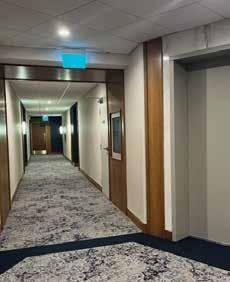








interface (API) to enable better information exchange with the licensed short-term rental platforms. The audit report further recommends advanced analytics and automation to focus on six indicators of rules violation.
The following are considered plausible-to-strong hints that short-term rental accommodations are not located in registrants’ principal residence:
• exceeding the limit of 180 nights per year for rentals;
• renting out more than three bedrooms per night;
• owners with multiple short-term rental properties:
• properties with legally approved secondary suites;
• using the same registration number for multiple properties; and
• relying on professional property management.

Our staff are provided with the tools to handle challenging situations. We bring the flexibility that is needed to adapt and adjust to all situations. We pride ourselves on our “Service First” approach, where we engage first upon noticing someone. We believe in focusing on customer service as it sets the tone and presence of our staff.



These are all risks that human administrators are currently monitoring through intuitive, labour-intensive processes.
“To pinpoint non-compliance, the MLS (municipal licensing and standards) compliance team primarily analyzes the transaction data for short-term rentals, focusing on past violations and active noncompliant listings. They target suspected operators, looking particularly for violations of the threebedroom rule, by manually analyzing the transaction data,” the audit report advises.
During the period covered in the review, the auditor found that:1,438 housing hosts may have exceeded the 180-night limit; 545 may have exceeded the three-bedroom limit; and 170 may own more than one short-term rental property. Notably, 1,100 of the registered homeowners had a different mailing address for their property tax bill than that for the short-term rental accommodations. As well, there are concerns about pirated and noncompliant registration numbers showing up in listings on the short-term rental companies’ platforms, which are evident in a mismatch of information for advertised and registered properties bearing the same number.
Airbnb’s voluntary agreement to collect and remit MAT on behalf of registered housing hosts who are listed with the platform is described as “beneficial” for the City of Toronto. “It improves compliance, simplifies tax deduction at the source, streamlines collection, reduces reliance on remittance by operators and reduces the administrative burden on City staff,” the audit report maintains.
Nevertheless, the auditor calls for more transaction details from both Airbnb and the smaller number of housing hosts who collect and submit MAT themselves. The latter group is simply required to remit a lump sum and declare the number of nights of rentals it represents. Airbnb does submit transaction data separately to the licensing department, but this typically chronicles patrons’ check-in and check-out dates rather than when payment was received.
“Without additional transaction details accompanying remittances, reconciling or verifying the accuracy and completeness of Airbnb’s MAT remittances is challenging,” the audit report states. “Operators who remit the tax themselves are not required to provide transaction details. This results in the City relying on an honour system, expecting operators to collect and remit the correct amount of MAT.”
It’s recommended that Toronto’s revenue services department establish a quarterly reconciliation process to compare MAT remittances












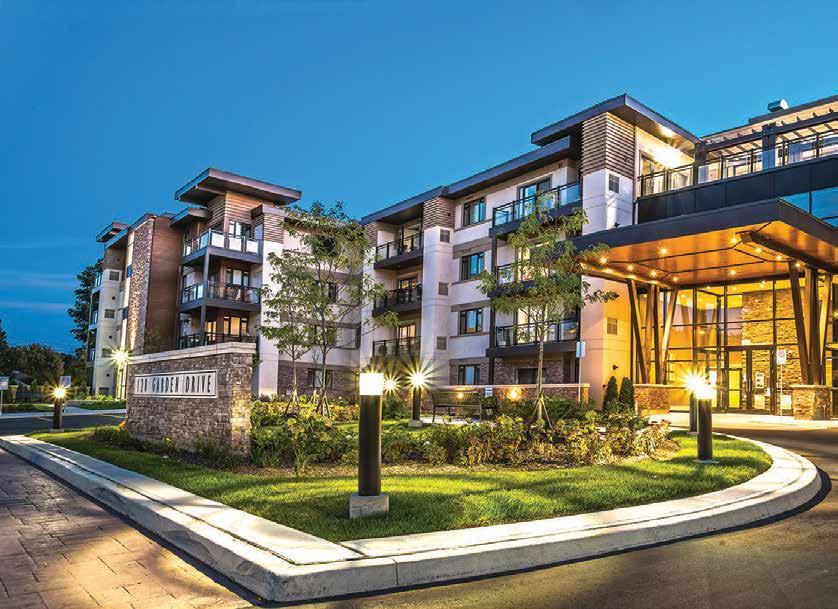

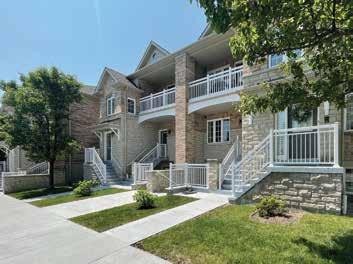



from more detailed transaction data that Airbnb and other short-term rental facilitators would be required to provide. Random “sampling and comparing” procedures are also proposed for housing hosts.
consent from landlords and condo corporations
Among key concerns for landlords and condominium corporations, the audit report calls for more vigilance to ensure renters have the unit owner’s consent, and that offered condo units are not located in buildings where short-term rentals are prohibited. The City currently does not require proof that tenants have permission to rent out short-term accommodations in their units, but there is an expectation that they do and that they will also abide by Ontario’s Residential Tenancies Act when they effectively become landlords.
The audit report cites examples of other cities, including Ottawa, Vancouver and New York, that directly inform property owners when tenants apply to register units for short-term rentals or require tenants to submit written consent from their landlords with their applications — and suggests a similar policy could better protect Toronto against liability. As of January 2024, three lawsuits had been registered against the City for neglecting to confirm a tenant had the landlord’s permission.
“The City needs to clarify the roles and responsibilities regarding landlord-tenant matters of all involved parties and consider adopting risk-based sampling procedures in the future for verifying landlord consent for short-term rental registrations,” the audit report states.
Meanwhile, the auditing team sampled the 20 downtown condo buildings that sport the highest concentration of registered short-term rental units (collectively amounting to 1,459 units). That exercise uncovered 42 registered units in a building that prohibits short-term rentals along with 41 scenarios where renter occupants had registered a unit even though condo rules restricted shortterm rental hosting to owners only.
Toronto’s licensing department does keep a list of condominiums that have rules restricting or prohibiting short-term rentals, which numbered 145 buildings when the audit was conducted in January 2024. However, the report suggests more proactive monitoring could be employed at the application stage, rather than drawing on the information to revoke registrations at a later time.






























































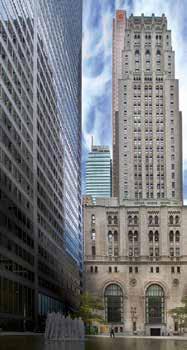











Retaining property managers, cleaning staff and security personnel
Staff play an indispensable role in maintaining a community's wellbeing and safety, as well as the financial health of the corporation.

BY TODD HOFLEY

From the property manager who oversees daily operations, to the cleaning staff who keep spaces immaculate, to the security personnel who bring peace of mind and are often the first smile residents see each day, their contributions are invaluable but often underappreciated.
Retaining these essential employees is a reflection of a community's values and makes savvy business sense. A high turnover rate disrupts the belonging that residents strive to foster, incurs unnecessary costs associated with recruitment and training, and may be an


indication of a culture gone wrong. This is why it’s crucial to prioritize employee retention through a multi-faceted approach that acknowledges their unique needs, contributions and situations.
While, technically, all of a condominium’s employees work for another company, legally, a condo board has a duty to ensure their work environment is safe, inclusive and welcoming.
If employees aren’t happy with their working conditions, a corporation can collaborate with its management company to make improvements.
Property managers: the heart of a community
While condominiums come in all shapes and sizes, property managers will be the linchpin of the community—even if they interact less with residents compared to cleaning staff or security. They are tasked with navigating myriad responsibilities, so recognizing their expertise and dedication is paramount.
One strategy that can be particularly effective is providing annual performance-based bonuses. In my own condo, this is set at a base level of 5 per cent salary, which can move up or down depending upon their execution. Last year, there
were several large projects that came in substantially under budget because the manager dug for deals and used her network. She was given a portion of those savings to recognize her extra work.
On top of this, inviting property managers to participate in community events, such as holiday gatherings or barbecues, reinforces their integral role. Understanding and accommodating their commuting needs, such as flexible work hours or assigning a parking space, also demonstrates empathy and consideration.
Cleaning staff: the unsung heroes
Cleaning staff make shared living spaces hygienic and inviting, contributing significantly to residents’ quality of life. Annual bonuses can be tied to performance evaluations to acknowledge their commitment to maintaining a community's standards. Setting a minimum wage above provincial guidelines also acknowledges the many staff who have extremely long commutes by bus and train.
As well, a simple thank-you note, a small gift card, and quarterly lunches for all employees boost morale and foster a sense of belonging. Be mindful of their working conditions and ensure access to proper cleaning supplies and equipment.
Security personnel: guardians of our safety Security personnel work tirelessly to safeguard their communities, often in challenging circumstances. Annual bonuses of up to 5 per cent can increase with seniority. Helping out by paying for new shoes, lunches, and the occasional note of thanks also goes a long way.
This retention strategy may sound costly, but added up, it equates to about 2 per cent of the overall budget in my own building. Over the past 10 years, we have monitored the savings generated by this approach and found the return to be roughly four to five times. Our property manager, who has been with us for 12 years, saved us more than $80,000 last year alone.
When an emergency happens, our staff, regardless of title or responsibility, will jump in to help, saving further amounts of money. Additionally, cleaning staff are the eyes and ears in the building. They know if something sketchy is happening or if someone is in distress. Having an invisible ear to the ground is immeasurably valuable when assessing and mitigating risks within any communal building.
Implementing these types of retention strategies cultivates a dedicated and loyal workforce that enhances the quality of life within a community and saves the corporation significant dollars. When thinking holistically and with empathy, it becomes a win-win-win-win. 1
Todd

















































Understanding green condos to meet sustainability targets
Reaching net zero by 2050 means sustainability targets for all buildings, both old and new, will need to change quickly. This includes existing condo buildings.
BY JACK ALBERT AND WENDY MACDONALD



Asbuilding performance levels increase at an accelerated rate, it’s not surprising that condos built several decades ago will start falling behind the status quo if upgrades are not made. Choosing the right building energy and sustainability revamps is critical for keeping pace with today’s green ambitions.
When it comes to energy upgrades, the best candidates are condo buildings that need some work done anyway. For example, if a building already has windows, a roof and HVAC (Heating, Ventilation and Air Conditioning) systems all in need of replacement, then it just comes down to looking at the premium to get the best possible product while optimizing integration. That’s exactly where an energy study comes in.
The energy study can be coupled with a life cycle assessment (LCA) to assess other environmental impacts of potential building upgrades. This includes analyzing the condo’s
carbon footprint, both embodied and operational.
Currently, a major focus is minimizing embodied carbon in buildings, and this is where existing condos have an advantage; the building with the lowest embodied carbon is the one that has already been built.
A vital strategy in this “time value of carbon” approach is to maintain existing buildings. This cuts out all the embodied carbon emissions that are associated with material extraction, manufacturing and construction of a brand-new building. Energy models and LCAs are vital decision-making tools, as they help owners analyze embodied carbon and greenhouse gas emissions on their projects, as well as energy use and cost.
Window replacement
Improved insulation for windows trickles
down to improved energy efficiency. When condo windows are replaced, less energy is needed to regulate temperatures, saving work for the HVAC system.
For older condos in the 30- to 50-year range, window replacements have a major impact on occupant comfort and energy use. As a weak point in the building envelope, windows transfer a significant amount of heat and they can leak.
Energy modelling can be leveraged to compare the benefits of high-performance windows versus standard windows. This often includes looking at energy savings to estimate the payback on the premium investment, as well as how high windows need to perform to allow for a smaller or electrified HVAC system.
Trained professionals can best assess different options for window replacements, working with a board to set clear priorities. Sometimes the right approach








The Zero Emissions Innovation Centre (ZEIC) has launched the BC Retrofit Accelerator (BCRA), a three-year $20-million program aimed at kick-starting climate and energy upgrades across hundreds of the province’s commercial and residential buildings.
With funding from Natural Resources Canada, the Ronald S. Roadburg Foundation, Metro Vancouver, ZEIC, and others contributors, the BCRA will provide hands-on guidance to the owners and managers of larger commercial and residential properties—including strataowned, rental, non-market, and off-reserve Indigenous housing.
Over the next three years, the BCRA aims to deliver decarbonization plans for 500 large existing buildings, each showing a path to zero emissions by 2050 aligned with major capital renewals.
Many property owners and managers, including strata councils, want to upgrade and decarbonize their buildings by transitioning to all-electric heating, cooling, ventilation, or water heating. But they grapple with a range of barriers, including low awareness, complexity, and challenges in sourcing financing.
The program will provide expert coaching for all stages of a retrofit project, such as identifying technology and financing options and support through procurement and implementation. By navigating building owners and managers through the upgrade process, the BCRA aims to spark deep energy retrofits—including the installation of heat pumps or distributed renewable energy systems—in 125 larger properties across the province.
means replacing the windows and frame. This can be costly, but ultimately yield stronger performance. Other times, just the glass can be replaced, creating cost efficiencies and less disruption for residents.
Replacing your condo building’s roof does so much more than keeping rain and snow out; it also improves overall energy efficiency by creating better insulation. Much like for window replacements, energy modelling can be used ahead of roofing replacements to determine the return on investment garnered from higher amounts of insulation.
While window and roofing upgrades call for simple lifecycle replacements, cladding is often not fully replaced but rather maintained. For example, brick or precast cladding can last as long as 75 to
100 years without any full replacements needed. That being said, cladding systems are sometimes replaced or overclad in response to leaks, new goals to elevate an older condo aesthetic or to improve energy performance.
If overcladding or recladding is already being considered for a condo complex, a deep energy retrofit may be a good fit. It is recommended to bundle the cladding upgrade with window and roofing replacements, plus an energy study to unveil whether the HVAC system can be improved or minimized in any way.
The main driver behind a building’s carbon emissions will depend on its heating and hot water systems, which can be fossil-fuel fired or electric. Dubbed “fuelswitching,” changing from oil or gas to an efficient electric system can be the fastest way to reduce a building’s operational carbon emissions.
Older buildings often have what would now be considered insufficient ventilation: an issue brought into public awareness amid the COVID-19 pandemic. Energy audits are a great way to analyze the building as a whole and determine the best strategies to improve both energy efficiency and carbon reduction. While replacing HVAC systems may be critical for lowering operational carbon, upgrading the building envelope is a solid first step. This often results in a smaller, and therefore less costly, HVAC replacement.
Many current projects feature replacement for windows and heating/cooling systems, such as changing PTAC (packaged terminal air condition) units to more efficient split systems. This improves comfort and reduces energy usage with a minimal premium, if any, over simple end-of-life replacement costs. These upgrades are also easily completed in existing buildings while they’re occupied.
Contractors are knowledgeable and experienced in the work and coordination involved, reducing the cost and impact on the owners.
Many elements in a condo’s building envelope will last 30-plus years. A typical end-of-

life replacement is often the only chance to make meaningful energy changes that will last decades. Coordinating these vital energy upgrades all together can maximize building performance. However, replacing these elements independently or without smart improvements means missing out on a oncein-a-generation opportunity to really improve
building performance, reduce environmental impact, and position the building attractively in the marketplace.
This is where evaluating all options is critical. Using tools such as LCAs and hourly full building energy models allows the board to make informed decisions based on buildingspecific data and comprehensive options. 1
Jack Albert, MEng, P.Eng., LEED® AP, is a Principal at RJC Engineers.
Wendy Macdonald, P.Eng., ENV SP, LEED® AP BD+C, is a Sustainability Consultant at RJC Engineers.








In the dynamic world of high-rise and commercial janitorial services, where pristine cleanliness is paramount, WhiteRose Janitorial stands as a beacon of excellence. Since our inception in 1986, we have committed ourselves to delivering top-tier cleaning services while fostering a professional and compassionate work environment.
At WhiteRose Janitorial, we recognize that each building has unique needs and demands. Our bespoke cleaning schedules are meticulously tailored to
meet these specific requirements, ensuring clients receive precisely the level of service they need without unnecessary sta ng or costs. This customized approach optimizes resource allocation, enhancing e ciency and guaranteeing superior cleanliness and attention to detail.
Our innovative practices set us apart in the industry. WhiteRose Janitorial utilizes advanced cleaning systems to prevent cross-contamination, ensuring a safe and hygienic environment for all. Our rigorous three-tier management supervision ensures strict adherence to schedules and maintains the highest standards of quality across all our services.
Upon initiating our services in a new property, our commitment to thoroughness becomes immediately apparent. We conduct comprehensive cleaning assessments, meticulously reviewing every corner of the property, including often overlooked areas such as electrical closets, storage rooms, and mechanical rooms. Our dedication to excellence extends to high-tra c areas such as lobbies, where our detailed cleaning routines ensure these spaces remain immaculate.
WhiteRose Janitorial values and supports our sta ’s dedication and adaptability. Our structured sta ng levels promote a clear chain of command, enhancing e ciency and cohesion within our teams. Regular inspections by area managers, coupled with open communication with cleaning sta , ensure consistently high standards of cleanliness. Our performance-based
incentive program for management rewards excellence based on client-centric metrics, such as site inspections, health and safety measures, and client satisfaction scores.
Beyond our commitment to quality service, WhiteRose Janitorial is dedicated to making a positive impact in the community. We proudly sponsor a room at the Ronald McDonald House for Toronto’s Hospital for Sick Children. Our sta generously donates their time and resources, volunteering and serving food at the Ronald McDonald House, making a meaningful di erence in the lives of families in need.
Despite our superior cleaning services and continuous investments in innovation, WhiteRose Janitorial remains competitively priced. Our proactive approach and attention to detail ensure tasks are e ciently allocated, delivering impeccable results and reducing overall costs for our clients.
The foundation of WhiteRose Janitorial’s success lies in building valuable and reciprocal relationships. Our
dedication to exceptional service and community initiatives sets us apart in the industry. For a cleaning company that goes beyond the ordinary, o ering competitive pricing and unparalleled service, WhiteRose Janitorial is the perfect choice to elevate your property’s cleanliness and operational e ciency.
Discover how a structured cleaning schedule can transform your property. Contact WhiteRose Janitorial today for a complimentary white-glove inspection of your facility v visiting www.whiterosejanitorial.com
Experience the di erence of a truly professional janitorial service.






WhiteRose Janitorial doesn’t just clean; we elevate your environment to new standards of excellence.



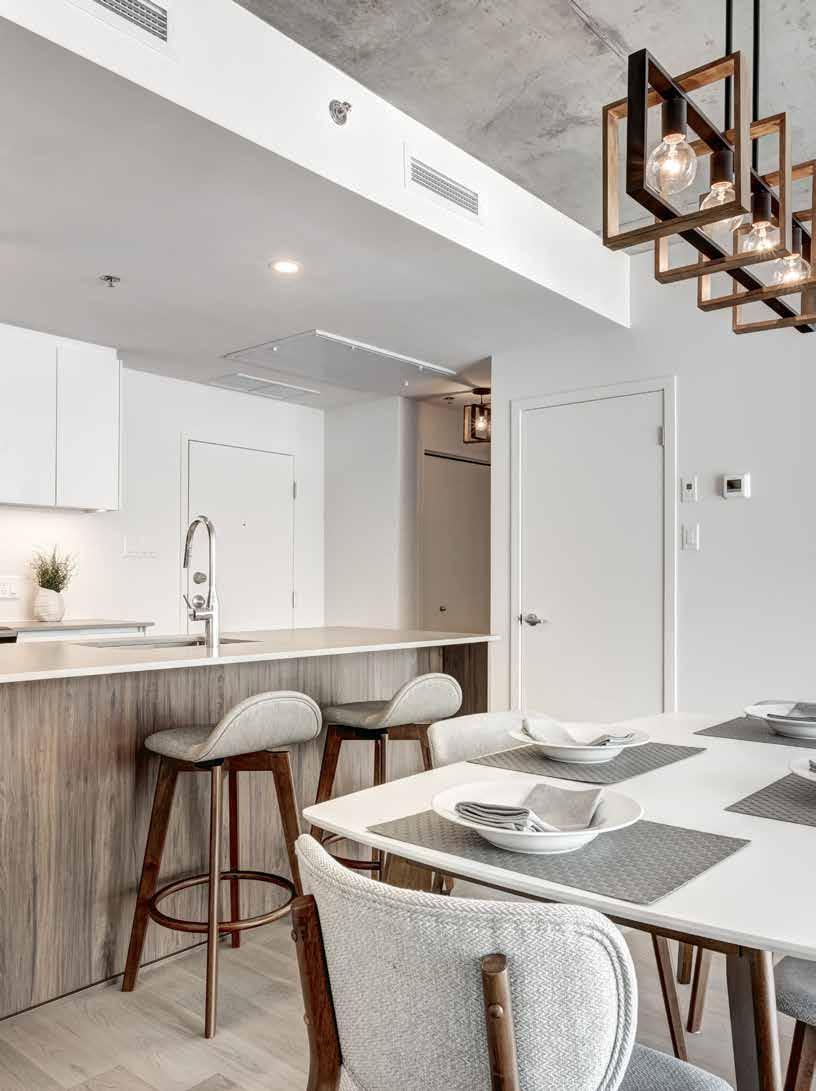
Maximizing the functionality of modern condo living
As living costs continue to skyrocket, particularly in urban centres like Vancouver and Toronto, the way people think about their living spaces is changing. With the average home in these cities costing well above $1 million, the value of each square foot has reached unprecedented levels.
BY EARL DUCHARME
At the forefront of this shift is a focus on small space design—an area where innovative thinking and smart solutions are essential as designers and homeowners look for ways to justify the growing price tags on modestly-sized properties.
Emerging trends in condominium design
Many of the design trends that have long been popular in Europe are making their way across the Atlantic and into North American cities. The move towards minimalism, driven in part by the high cost of living and the desire for more sustainable lifestyles, is reflected in the trend towards smaller, more efficient living spaces.
One of the most significant trends is the partitioning of spaces for both aesthetic and functional purposes. This includes uncluttered features like hidden kitchens and coffee centres that can be concealed behind panels, where you can create what has become known as the “appliance garage.”
Another trend gaining traction is the shift from traditional cabinets with swing doors to base cabinets that primarily feature draw-

ers for versatility. In upper cabinets, European-inspired flap stay hardware is being integrated more frequently. This hardware allows upper doors to swing, fold, or accordion, providing easier access to traditionally inaccessible areas. From an aesthetic standpoint, cabinets that extend to the ceiling are
becoming the norm, contributing to a sleek, modern look.
The use of different types of wood, particularly in natural and darker tones, add depth and warmth to spaces, aligning with a broader movement towards designs that feel both contemporary and timeless.

Furniture selection and orientation
Understanding how a space is used on a day-to-day basis and how needs evolve will help maximize functionality without sacrificing aesthetics. Every detail matters, from the placement of furniture to the choice of materials and finishes.
Innovative storage solutions and multi-purpose furniture are playing a critical role in this regard. For instance, wall beds, also known as the murphy bed, have seen a resurgence in popularity, particularly in rooms that serve as both a bedroom and an office or entertainment space.
Drawer organizers for utensils, pots, and pans, as well as spice rack pull-outs positioned near cooking worktops, are becoming standard rather than an upgrade in kitchen design. Waste management solutions that fit into lower cabinet pull-out drawers are now commonplace, reflecting a European influence that North American design has embraced.
Good lighting can make a small space feel larger and more inviting. Task lighting, functional lighting, and atmospheric lighting each have their role to play in small space design. Solutions that combine light within furniture—in shelving, under cabinetry, surrounding bed frames—create an integrated, fully-connected experience that enhances the material and texture within a room and various living spaces, whether for relaxing, entertaining, working, etc.
The importance of thoughtful furniture selection and orientation is increasingly apparent while navigating the challenges of multi-residential living. By choosing pieces that serve multiple purposes and arranging them to enhance flow and functionality, condo dwellers can create spaces that are efficient and inviting. 1
Earl
Ducharme is the managing director at Häfele Canada Inc.


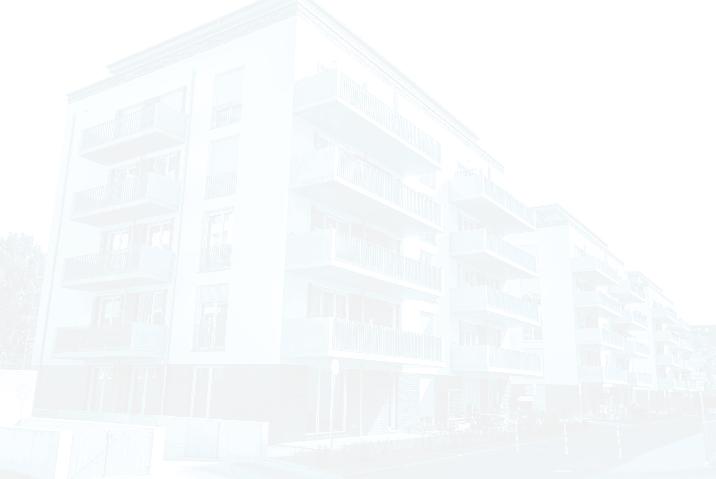







The Building Operations Designation (BOD) Program is creating a new standard for the commercial real estate industry and Building Operations professionals through current, relevant, engaging, and interactive training content with ongoing insights and information through continuing education, special events and direct access to industry subject matter experts.


The BOD Program is online, self-paced and includes a robust, ongoing continuing education component. For more information, please visit BODProgram.com
























In tandem with the commercial real estate industry and over 450 recognized subject matter experts, we are proud to offer the BOD Program and its 22 certificates to all Building Operations professionals.


Over 2,900 real estate and operations professionals have already registered across Canada and many have attained various BOD Program certificate diplomas.





Proudly Developed and Delivered by:

If you and your staff are interested in registering for the BOD Program, please contact Chuck Nervick at chuckn@mediedge.ca or 416-803-4653.




By Bri Macdonald
Getting a home ready for potential buyers can feel a bit overwhelming, but it’s really about making the space look its best. Here are some tips to do just that.
1. Declutter and create space: Before staging, go through each room and remove items that are no longer needed. This makes a space appear larger and helps with packing for a move. In smaller units, three key tricks can create the illusion of more space. First, opt for lighter shades on walls, furniture, and decor to create an airy feel that reflects more light. Second, mirrors are your best friend. Strategically place them to reflect light and create the illusion of depth. A large floor-to-ceiling mirror on one wall can make a big difference. Lastly, arrange furniture in a way that promotes natural flow and movement. Avoid placing large pieces in the centre or blocking pathways.
2. Deep clean: A clean home is essential. Dust, vacuum, and scrub every surface. Pay special attention to kitchens and bathrooms, as these areas can make or break a buyer’s impression.
3. Go neutral: Bright and bold colours tend to distract and make it hard for potential buyers to envision their own style in the space. Consider repainting with neutral tones.
4. Depersonalize: Remove family photos, personal memorabilia, and anything that might distract buyers from imagining themselves in the home.
5. Highlight key features: Make sure the home’s unique architectural details or features stand out. Arrange furniture and decor to draw attention to them.
A beautiful fireplace mantel can serve as a stunning focal point when furniture and colour schemes are arranged thoughtfully around it. Use exposed beams to showcase high ceilings for character and warmth.

6.
Don’t forget the outside: Whether it’s a patio, a small back or front yard or a balcony, there’s a way to freshen it up. Add potted plants or flowers to create a welcoming environment or trim the hedges. For townhomes, if the entrance or siding needs a quick paint touch-up, take extra time to give it curb appeal.
7. Lighting: Ensure all rooms are well-lit. Open curtains for natural light and use lamps strategically to brighten up darker areas.
8.
Add inviting touches: Consider fresh flowers, a bowl of fruit, or a few cozy throws to create a warm and inviting atmosphere, or even some freshly baked cookies before every open house.
9.
Get feedback: Before showings, ask friends or family for their honest opinion about your staging efforts. Sometimes an
outside perspective can help identify areas for improvement.
10. Consider professional staging: If the furniture screams mismatched, uncoordinated, or may be a bit of an eye sore, consider investing in a professional stager who has knowledge about enhancing the appeal of your space.
Staging your home doesn't have to be costly or time-consuming. Even in an older condo, simple upgrades can truly transform a space. For instance, adding new knobs to kitchen cabinets or giving a wall a fresh coat of paint can dramatically improve the look without breaking the bank. 1
Bri Macdonald is an interior designer and contributing writer for several North American publications on topics related to interior design.

Dec 4 - 6, 2024
Metro Toronto Convention Centre
Nearly 2,600 condo units being built at the 21-acre Heather Lands site in Vancouver will be sold at 60 per cent market value, with the province of British Columbia covering the other 40 per cent of the cost. The attainable housing initiative was announced as a joint financing partnership between the province and the Musqueam, Squamish and Tsleil-Waututh (MST) Nations.
The initiative will allow for studio, one-, two- and threebedroom 99-year strata leasehold homes to be initially purchased and financed by middle-income earners at below-market prices, with priority going to first-time homebuyers.
“Ten years ago, Musqueam, Squamish and Tsleil-Waututh signed groundbreaking agreements that led to our Nations working together to regain ownership of several properties within our shared territories,” said Musqueam Chief Wayne Sparrow.
Property developer Rachel Julien launched the first phase of Canoë, a mixed-use residential development in the Mercier—HochelagaMaisonneuve district of Montreal.
Canoë proposes an urban solution to current housing issues and will accommodate more than 900 condos and rentals, cooperative housing units, small local shops, a daycare centre, public spaces, and a park. Sustainability plans include heat recovery from grey water, recovering remaining energy from electric vehicles via reversible terminals and collecting energy generated by humans exercising on gym equipment.
The first phase of a $6-billion shopping mall redevelopment project is launching this fall in Toronto’s west-end. Mattamy Homes and QuadReal Property Group released final designs for The Clove, a 33-storey tower with an adjoining nine-storey mid-rise building, which will rise on the 32-acre site of the Cloverdale Mall.
The buildings will create 600 condominium units (studios to three bedrooms) atop 2.3 acres at 2 and 10 The East Mall Crescent in central Etobicoke.
“This relationship has evolved, and we are proud to collectively introduce this new initiative that will ease the housing crisis faced by our members and the general public.”

The partnership will include MST Nations providing the land and the government of B.C. contributing up to $672 million, which is expected to be repaid by purchasers to the province under the initiative. The province will reinvest returned funds into future provincial programs such as housing.
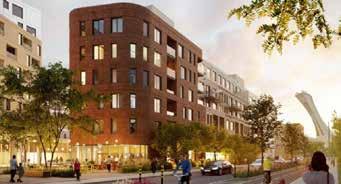







































We offer a full suite of simple, predictable, all-inclusive banking solutions tailored to the property management sector. Our industry experts are here to support you every step of the way.

Operating and reserve fund accounts


Treasury expertise

Financing for acquisitions, expansions and real estate
Contact the CIBC property management industry team today 905 273-3584 or mailbox.nationalindustryprograms@cibc.com